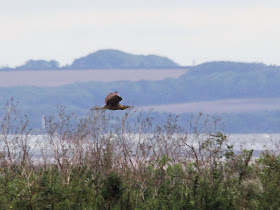The 1st session after the long summer break saw us concentrating mainly on wading birds. We were going somewhere with plenty of hides, so it was safe to ignore the rather damp early morning forecast - which rather surprisingly was wrong anyway! The first hide may have been a little confusing for first timer Maggie, as it was absolutely packed with waders. The Lapwings were the most obvious, but there was also a very noticeable white-headed male Ruff. There were also juvenile male ruffs and a buffish female Ruff - or Reeve, much smaller than the other juveniles.
In addition there were some of the closest views we've ever enjoyed of Greenshanks, and in good numbers too. There was a single Green Sandpiper and a couple of moulting Dunlin, but nothing really out of the ordinary. A single Spotted Redshank busy feeding in the deepest water was a very nice sighting. It wasn't particularly close so most people had a better view through the telescope.
Ruff
Ruff with Snipe [left]
Greenshank
Greenshanks
Greenshank & Redshank [right]
Record shot of Bittern
Record shot of Bittern
In the next hide we were quickly put on to a Bittern which was perched at the top of the reeds, looking rather windswept. We were told to try & photograph this distant bird as best as we could, because they were trying to discover if this was an old juvenile, as there are still some young birds being fed on the reserve. The ducks were mainly in eclipse, but we could ID Shoveler and Gadwall, and a juvenile Shelduck. A young Cormorant flew in and immediately hung its wings out to dry.
Ditto
Blackcap
Cormorant
Moorhen
Wigeon
Heron
Magpie
Speckled Wood
Konik Ponies
Record shot of Little Grebe
When we went to another hide there was a pair of young Little Grebes with 3 very young chicks. This has put back some of the conservation work back several weeks. There are also young Tufted Ducks and I think Shovelers on the reserve. There were a few calls of Bearded Tits from this hide, but they resolutely remained completely out of sight, though we did see a Reed Bunting, young Sedge Warblers, and a charm of Goldfinches.
The remaining hides just produced more of the same, but one hide had a great numbers of winter-plumages Spotted Redshanks on display, with one bird with slightly more spangly plumage. There was another Green Sandpiper here, which we'd a little bit better than the earlier bird. A Blackcap eating elderberries was the passerine highlight of the afternoon session.
The final hide brought more distant views of Snipe, Greenshank, Redshank and 5 more Spotted Redshank. We did see a few Marsh Harriers in flight from time-to- time, but we were told that these had dispersed much earlier than normal, which seems to be the opposite of most of the other birds, which are breeding much later in the season than is usual, but this is almost certainly because of the disastrous early start they had!


















Some nice shots there.
ReplyDelete